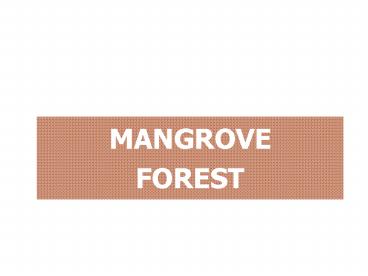MANGROVE FOREST - PowerPoint PPT Presentation
1 / 24
Title:
MANGROVE FOREST
Description:
MANGROVE FOREST OBJECTIVES Describe the distribution of mangroves. Describe climatic features of MG areas. Describe & explain the features of MG. – PowerPoint PPT presentation
Number of Views:342
Avg rating:3.0/5.0
Title: MANGROVE FOREST
1
MANGROVE FOREST
2
OBJECTIVES
- Describe the distribution of mangroves.
- Describe climatic features of MG areas.
- Describe explain the features of MG.
- Describe the adaptations of MG.
3
DISTRIBUTION
- along sheltered coastal regions
- Found b/w 23.5N and S of the equator.
- areas experiencing tropical climate
4
STRUCTURE
- 3 distinct horizontal zones
- No vertical layers
5
Horizontal zonation of Mangroves
- http//www.mesa.edu.au/mangroves/images/mang_zones
.jpg
6
STRUCTURE
- Coastal Zone
- Nearest to the coast
- Adapted to salt water
- Aerial roots
- Avicennia, Sonneratia
- Inland Zone
- Grow inland
- Least tolerant of salt
- Knee-like roots
- Bruguiera
- Middle Zone
- Prop roots
- Stilt roots
- Rhizophora
7
CHARACTERISTICS
8
C1 Little Variety
- Mangrove is species poor as there are only 4 main
species present Avicennia, Sonneratia,
Rhizophora, Bruguiera - This is because only Halophytes (salt tolerant
plants) can survive in this region.
9
C2 Dense Luxuriant
- Most form a dense, continuous canopy due to the
presence of high temperatures and high rainfall.
10
C3 Sparse Undergrowth
- Little sunlight filters through the dense,
continuous canopy. - Hence there is little undergrowth present in this
layer.
11
C4 Evergreen leaves
- As there is high temperature and high rainfall
throughout the year, the leaves remain evergreen.
12
C5 Colourful flowers
- The flowers are generally colourful to attract
insects to pollinate its flowers.
13
C6 Buoyant Fruits
- This enables fruits to be carried away by waves
and currents to new coastal areas.
14
ADAPTATIONS
15
A1 High rainfall
- The leaves are broad with drip tips to enable
water to flow off the leaves quickly.
16
A2 High Temperature
- The leaves are thick and leathery to reduce water
loss through transpiration.
17
A3 Salt
- Avicennia are salt secretors They excrete excess
salt on their leaves which are then removed by
the wind or rain. - Bruguiera, Rhizophora, Sonneratia are
ultrafiltrators They absorb salt and store it in
the old leaves which fall off eventually.
18
A4 Oxygen Deprived
- Due to waterlogged conditions in the mangrove
environment, the soil is oxygen-deprived. - Avicennia and Sonneratia have aerial roots As
these roots are exposed during low tide, they
take in oxygen.
19
A5 Muddy Soil
- Prop Roots
- Rhizophora Stilt or prop roots which anchor the
roots firmly to the ground - Keed Roots (Knee-Like)
- Bruguiera Kneed roots that provide firm support
on the soft soil. - Fruits with elongated structure
- Rhizophora enables the fruits to anchor in soft
muddy soil.
20
PENCIL ROOTS
21
PROP ROOTS
22
KNEED ROOTS
23
BUOYANT FRUITS
24
THE END































